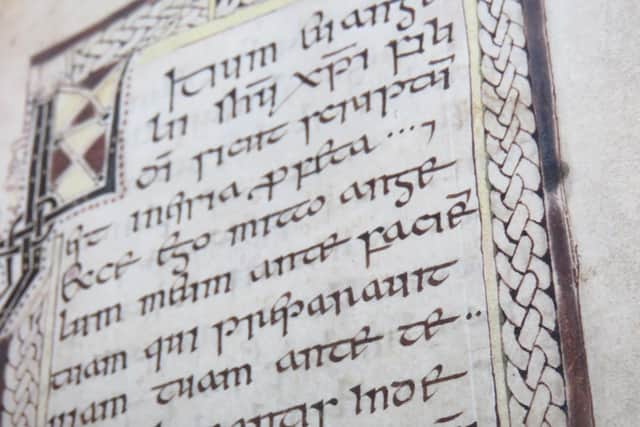Scotland's oldest surviving manuscript returns home after 1,000 years
The Book of Deer is a rare example of a pocket gospel book and was produced for personal use rather than for church services.
It was believed to have been penned in Aberdeenshire around 900 AD.
Advertisement
Hide AdAdvertisement
Hide AdThe text is in Latin but the book also contains the world’s oldest surviving example of written Scots Gaelic within its margins, thought to have been added around 200 years later.


Now, thanks to a £128,588 grant from the National Lottery Heritage Fund, the 10th-century tome will go on show at an exhibition in Aberdeen city.
The move comes as part of an initiative by the Book of Deer Project, a community heritage group based in Aden Country Park in Aberdeenshire.
The manuscript will be on loan from Cambridge University Library, where it has been kept since 1715, and will be exhibited at Aberdeen Art Gallery next summer as part of the Year of Scotland' s Stories initiative.
As part of the programme an archaeological dig will be carried out in the grounds of the ruined Abbey of Deer, established in 1219, to search for remains of an earlier monastery where it’s believed the Gaelic annotation – describing its founding by St Columba – were inscribed on the pages.


A series of community cultural events and educational work with local schools will also take place in the region to celebrate the book and its heritage, with parallel events being planned in Cambridge.
Project partners include Cambridge University Library, Aberdeen City Council/Aberdeen Art Gallery, Live Life Aberdeenshire, the sports and cultural service of Aberdeenshire Council, the University of Aberdeen and Cameron Archaeology.
Anne Simpson, chair of the Book of Deer Project, said: “Ours is a small corner of the world, but it is an important one.


Advertisement
Hide AdAdvertisement
Hide Ad“The return of the Book of Deer and the exhibition at Aberdeen Art Gallery, along with the community dig and cultural programme, will allow us to celebrate the manuscript’s links with north-east Scotland in a manner it deserves.”
Marie Boulton, culture lead for Aberdeen City Council, said: “The Book of Deer is a work of national importance with strong local significance.
“We are very much looking forward to working with partners to bring this remarkable 10th-century Latin gospel book to the city for the first time and sharing its story with visitors to Aberdeen Art Gallery.”
Dr Jessica Gardner, Cambridge University librarian, said: “The Book of Deer is of supreme cultural importance to Scotland generally, and for the north-east of Scotland in particular, and this project has our strongest and warmest support.
“It offers an unparalleled opportunity to connect new audiences with heritage in an inspirational way that will leave a lasting legacy.”
Anne Stirling, chair of Aberdeenshire Council's Communities Committee, added: “Just imagine how exciting it would be if the community dig taking place next summer was finally able to identify the site of the Monastery of Deer, adding further to the fascinating story of the Book of Deer and its legacy in the north-east.”
A message from the Editor:
Thank you for reading this article. We’re more reliant on your support than ever as the shift in consumer habits brought about by coronavirus impacts our advertisers.
If you haven’t already, please consider supporting our trusted, fact-checked journalism by taking out a digital subscription.
Comments
Want to join the conversation? Please or to comment on this article.
